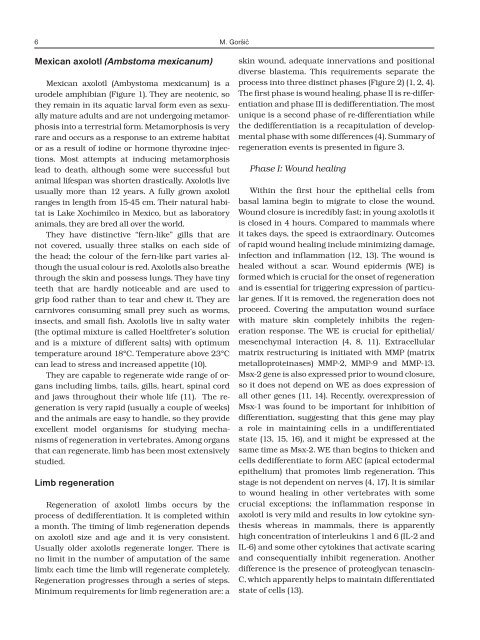Slov Vet Res 2007; 44 (1/2) - Slovenian veterinary research
Slov Vet Res 2007; 44 (1/2) - Slovenian veterinary research
Slov Vet Res 2007; 44 (1/2) - Slovenian veterinary research
You also want an ePaper? Increase the reach of your titles
YUMPU automatically turns print PDFs into web optimized ePapers that Google loves.
6<br />
M. Goršič<br />
Mexican axolotl (Ambstoma mexicanum)<br />
Mexican axolotl (Ambystoma mexicanum) is a<br />
urodele amphibian (Figure 1). They are neotenic, so<br />
they remain in its aquatic larval form even as sexually<br />
mature adults and are not undergoing metamorphosis<br />
into a terrestrial form. Metamorphosis is very<br />
rare and occurs as a response to an extreme habitat<br />
or as a result of iodine or hormone thyroxine injections.<br />
Most attempts at inducing metamorphosis<br />
lead to death, although some were successful but<br />
animal lifespan was shorten drastically. Axolotls live<br />
usually more than 12 years. A fully grown axolotl<br />
ranges in length from 15-45 cm. Their natural habitat<br />
is Lake Xochimilco in Mexico, but as laboratory<br />
animals, they are bred all over the world.<br />
They have distinctive “fern-like” gills that are<br />
not covered, usually three stalks on each side of<br />
the head; the colour of the fern-like part varies although<br />
the usual colour is red. Axolotls also breathe<br />
through the skin and possess lungs. They have tiny<br />
teeth that are hardly noticeable and are used to<br />
grip food rather than to tear and chew it. They are<br />
carnivores consuming small prey such as worms,<br />
insects, and small fish. Axolotls live in salty water<br />
(the optimal mixture is called Hoeltfreter’s solution<br />
and is a mixture of different salts) with optimum<br />
temperature around 18°C. Temperature above 23°C<br />
can lead to stress and increased appetite (10).<br />
They are capable to regenerate wide range of organs<br />
including limbs, tails, gills, heart, spinal cord<br />
and jaws throughout their whole life (11). The regeneration<br />
is very rapid (usually a couple of weeks)<br />
and the animals are easy to handle, so they provide<br />
excellent model organisms for studying mechanisms<br />
of regeneration in vertebrates. Among organs<br />
that can regenerate, limb has been most extensively<br />
studied.<br />
Limb regeneration<br />
Regeneration of axolotl limbs occurs by the<br />
process of dedifferentiation. It is completed within<br />
a month. The timing of limb regeneration depends<br />
on axolotl size and age and it is very consistent.<br />
Usually older axolotls regenerate longer. There is<br />
no limit in the number of amputation of the same<br />
limb; each time the limb will regenerate completely.<br />
Regeneration progresses through a series of steps.<br />
Minimum requirements for limb regeneration are: a<br />
skin wound, adequate innervations and positional<br />
diverse blastema. This requirements separate the<br />
process into three distinct phases (Figure 2) (1, 2, 4).<br />
The first phase is wound healing, phase II is re-differentiation<br />
and phase III is dedifferentiation. The most<br />
unique is a second phase of re-differentiation while<br />
the dedifferentiation is a recapitulation of developmental<br />
phase with some differences (4). Summary of<br />
regeneration events is presented in figure 3.<br />
Phase I: Wound healing<br />
Within the first hour the epithelial cells from<br />
basal lamina begin to migrate to close the wound.<br />
Wound closure is incredibly fast; in young axolotls it<br />
is closed in 4 hours. Compared to mammals where<br />
it takes days, the speed is extraordinary. Outcomes<br />
of rapid wound healing include minimizing damage,<br />
infection and inflammation (12, 13). The wound is<br />
healed without a scar. Wound epidermis (WE) is<br />
formed which is crucial for the onset of regeneration<br />
and is essential for triggering expression of particular<br />
genes. If it is removed, the regeneration does not<br />
proceed. Covering the amputation wound surface<br />
with mature skin completely inhibits the regeneration<br />
response. The WE is crucial for epithelial/<br />
mesenchymal interaction (4, 8, 11). Extracellular<br />
matrix restructuring is initiated with MMP (matrix<br />
metalloproteinases) MMP-2, MMP-9 and MMP-13.<br />
Msx-2 gene is also expressed prior to wound closure,<br />
so it does not depend on WE as does expression of<br />
all other genes (11, 14). Recently, overexpression of<br />
Msx-1 was found to be important for inhibition of<br />
differentiation, suggesting that this gene may play<br />
a role in maintaining cells in a undifferentiated<br />
state (13, 15, 16), and it might be expressed at the<br />
same time as Msx-2. WE than begins to thicken and<br />
cells dedifferentiate to form AEC (apical ectodermal<br />
epithelium) that promotes limb regeneration. This<br />
stage is not dependent on nerves (4, 17). It is similar<br />
to wound healing in other vertebrates with some<br />
crucial exceptions; the inflammation response in<br />
axolotl is very mild and results in low cytokine synthesis<br />
whereas in mammals, there is apparently<br />
high concentration of interleukins 1 and 6 (IL-2 and<br />
IL-6) and some other cytokines that activate scaring<br />
and consequentially inhibit regeneration. Another<br />
difference is the presence of proteoglycan tenascin-<br />
C, which apparently helps to maintain differentiated<br />
state of cells (13).
















